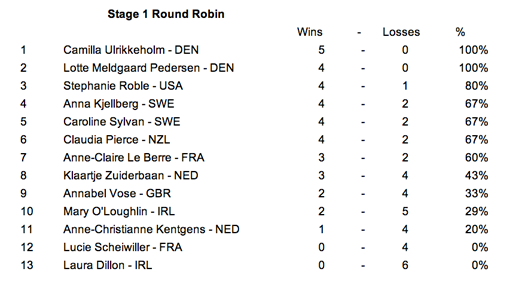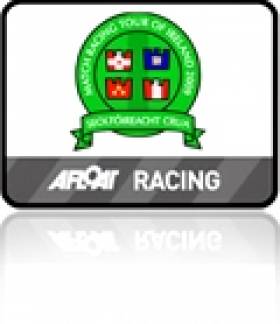Displaying items by tag: women's match racing
#wmr – The Petit Final led off today and provided a brilliant introduction to the display of match racing that was enthralling for the spectators to watch today writes Claire Bateman. Caroline Sylvan (SWE) put up a tough fight against Stephanie Roble (USA), but the American crew proved to be strongest at the end. With two straight wins they secured the bronze in the 2014 ISAF Women's Match Racing World Championship, the first event out of five on the 2014 Women's International Match Racing Series.
Finally the climax of this outstanding match racing event arrived and all were waiting with bated breath expecting a tremendous fight that lived up to all expectations and provided a display unequalled on the Cork Harbour scene for a number of years. Following a short delay to allow for the swopping of Stephanie Roble's (USA) boat, who in fact had come third in the series thus taking the bronze spot, all was in readiness and the scene set for the epic battle of the week and this in fact was what it turned out to be. With SSW breeze of 15 to 25 knots, a flooding tide, sunshine and shifty winds Anna Kjellberg of Sweden, World No. 2 and Camilla Ulrikkeholm World No. 1 entered the ding dong competition.
Ulrikkeholm gained an early advantage by winning the first match of the final. The flukey winds together with the flooding tide and strong current, really put it up to the sailors who gave it their all with a masterful display which was to last through the races for the final.
In the second match it was Kjellberg got through to victory and thus leaving it all to play for in match 3. Both teams started aggressively in race 3 with both clearly stating their intention to do the business. The Dane appeared to be in control of the situation when the Swede had a poor bottom mark rounding and it looked to be all over for her. However, the wily Swede went up the right side the beat and it paid off handsomely for her, taking the lead from the Dane and then held on in very tight circumstances and took the win.
Race 4 started with the tide turned. The start was again very aggressive with the Swede appearing to have the better of it. The wind seemed at it's strongest for this race. Both boats drag raced up the beat heading left. The Dane appeared marginally faster in the stronger conditions and got through. The pattern continued until the bottom mark when the Swede, who clearly wanted the right side of the course, threw a couple of dummy tacks to break the Dane's tight cover. Five minutes of racing later and it was all over bar the shouting. The smooth water on the right and a lucky shift took the Swede past the Dane and once through she never looked like losing and so it proved to be with the Swede taking the right hand side of the course downwind and gybing in the strongest breeze to power through to the finish and taking the winner's title in the final of the 2014 ISAF Women's Matching World Championships.
The prize giving followed in a very excited atmosphere with all very glad to be finished after a grueling week and showering the winner with congratulations and good wishes. A very lovely little human touch was added and made a perfect ending to the ceremonies when by kind permission of ISAF, Anna Kjellberg's little five week old daughter, Vera, was brought out to join with her mother to receive her very own gold medal to mark the auspicious occasion.
A wonderful end to a wonderful week.
ISAF Press Release
Olympic sailor and World #2 Anna Kjellberg of the Royal Gothenburg Yacht Club was crowned 2014 ISAF Women's Match Racing World Champion in Cork Harbour this afternoon. Together with her crew – Karin Almquist, Vanja Lundberg and Annika Carlunger – the Swede defeated Danish World #1 Camilla Ulrikkeholm (DEN) 3 – 1 in their Scandinavian battle off Crosshaven, the home of the world's oldest yacht club.
"This is absolutely incredible. We've never before sailed a regatta with such a great crew feeling," the Swedish skipper smiled. "The last few weeks of my life have been completely crazy, giving birth to my daughter just five weeks ago, and now this," she said, laughing and shaking her head.
With three victories needed to win the final of the 2014 ISAF Women's Match Racing World Championship, Ulrikkeholm gained an early advantage by winning the first match of the final. Strong but very shifting and puffy winds, together with a swift current, put the sailors to the test. The second meeting ended in a fierce fight around the course, but Kjellberg kept control and passed the finish line one boat length ahead of her opponent.
When the Swedes won the third match, they put Ulrikkeholm under great pressure to break back. In the fourth match the Danes got away ahead, but didn't cover the Swedes well enough on the second upwind. Kjellberg was allowed to tack away for clear air, found an advantageous wind shift and passed into a leading position which she was able to maintain to the finish.
"We've improved in every match during this regatta, and we know that in match racing it's never over until it's over. I think we had the right nerves today, with a rather calm feeling in the boat even when the competition was tough," Kjellberg analysed after her golden match.
On her loss Ulrikkeholm commented, "In these conditions it was hard also to be ahead. We made some mistakes not covering the Swedes enough, and then we didn't have as good boat handling as the other days of the regatta."
Kjellberg's bowman Annika Carlunger had no less than seven World Championship silver medals before this regatta, sailing with different helmsmen over the years. Now she got her eagerly awaited gold medal and shouted after having passed the finish line, "Finally, after all these years."
In the Petit Final Caroline Sylvan (SWE) put up a tough fight against Stephanie Roble (USA), but the American crew proved to be strongest at the end. With two straight wins they secured the bronze in the 2014 ISAF Women's Match Racing World Championship, the first event out of five on the 2014 Women's International Match Racing Series.
"We never felt comfortably in control, but my team did an awesome job all the way around the course," said Roble who praised her crew.
"We've done some fantastic races, and we're proud to be the second Swedish crew in the top four of this Championship," Sylvan smiled, not too disappointed.
Results in the 2014 ISAF Women's Match Racing World Championship, the first event out of five on the 2014 Women's International Match Racing Series:
Final:
Anna Kjellberg, SWE, defeated Camilla Ulrikkeholm, DEN, 3 – 1
Petit final:
Stephanie Roble, USA, defeated Caroline Sylvan, SWE, 2 – 0
Total results (skipper name, country, prize money, WIM Series points):
1. Anna Kjellberg, SWE, 3 000 €, 25
2. Camilla Ulrikkeholm, DEN, 2 000 €, 22
3. Stephanie Roble, USA, 1 500 €, 20
4. Caroline Sylvan, SWE, 1 250 €, 16
5. Anne-Claire Le Berre, FRA, 1 000 €, 15
6. Klaartje Zuiderbaan, NED, 750 €, 14
7. Lotte Meldgaard Pedersen, DEN, 500 €, 13
8. Claudia Pierce, NZL, – ,12
9. Annabel Vose, GBR, – , 10
10. Mary O'Loughlin, IRL, – , 8
11. Laura Dillon, IRL, – , 6
12. Lucie Scheiwiller, FRA, – , 4
13. Anne-Christianne Kentgens, NED, – , –
#corkharbour – Today the waters of Cork harbour saw the commencement of the first leg of the series to decide the 2014 ISAF Women's Match Racing Worlds Championship writes Claire Bateman
The initial stages of the competition started today with a Round Robin series where each skipper is scheduled to sail against each other skipper once and from there the top eight skippers will move on to the quarter finals from whence they will move on to semi finals, petit finals and the final. Racing will take place on this basis until Sunday, June 8th. By this stage one hundred and thirty one on one races will have been sailed.
A perfect June sailing morning with some 14 to 18 knots of North Westerly breeze going more towards the west as the day progressed, greeted the competitors on their arrival at the Royal Cork Yacht Club . With International Race Officer Peter Crowley in charge racing got under way on time. As forecast, some squally showers were experienced and provided some thrills and spills for both competitors and spectators.
Among the 13 international teams representing eight nations are two Irish entries skippered by Laura Dillon from Howth Yacht Club and Mary O'Loughlin from Royal St George Yacht Club in Dublin. The first race was between Dillon's Team Ireland 1 and Team Sweden 2 skippered by Caroline Sylvia. The first day nerves settled quickly and Dillon's team matched Team Sweden 2 on their every move. Team Ireland 1 crew Maria Coleman (ex-Irish Olympian) commented "The day was challenging for everyone, ensuring you gained the maximum of your upwind boat speed however this let us down a little today, but we know we have the pre- starts nailed". Unfortunately a mighty broach by Dillon cost the Irish team the race and it took some time to rectify.
Team New Zealand skippered by Claudia Pierce and crewed by her newly recruited Irish team mates had a sparkling day. "We had a great pre start against Anne Claire Le Berre's Team France pushing her out and making her do penalty turns at the start. This let us get away and sail clean for the race".
However, it was the two Danish teams that dominated the day. World #1 Camilla Ulrikkeholm and World #4 Lotte Meldgaard Pedersen ensured straight wins for all of their respective races. They were followed closely by Stephanie Roble of the USA with only one loss of the day
Forecast for tomorrow (Thurs) is for 10 to 14 knots from the south east.
Event organisers had planned a 'Sail in the City' festival for this Friday (06 June) but due to the forecast of heavy rain and strong winds the decision has been made to cancel the event.
All results provisional

Bid to Hold Women's Match Racing Event on Belfast Lough
In a further boost for the fledgling match racing scene here, top Irish international Umpire Bill O'Hara is looking to have the ISAF Grade one women's match racing event held on Belfast Lough from his home port of Bangor from August 17 - 20 2011, straight after the Weymouth pre-Olympic event.































































